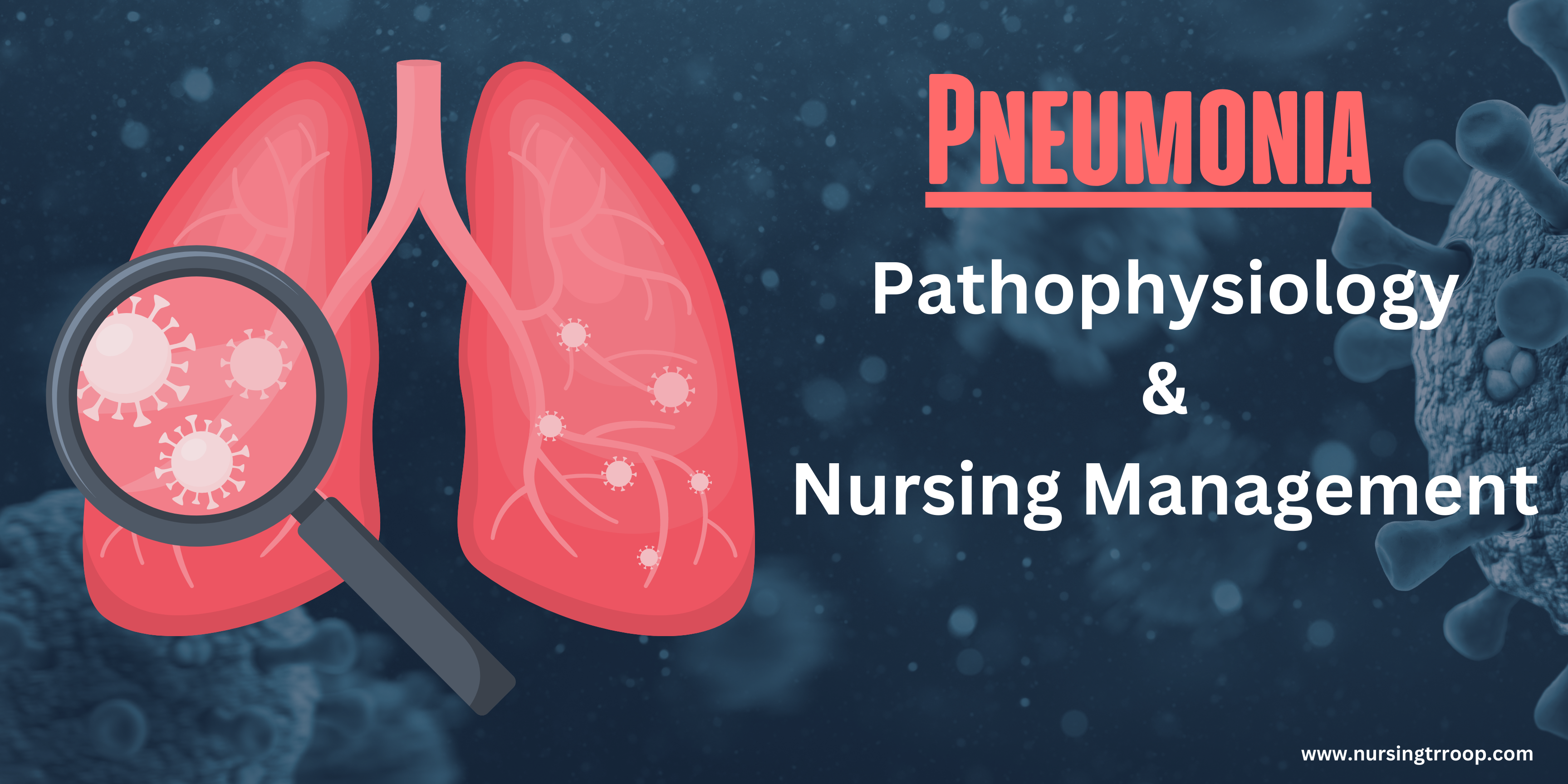Pneumonia is a common yet serious infection of the lungs. Understanding the pathophysiology and nursing interventions for pneumonia helps provide better care for those affected by this condition. It is critical to understand how the virus, bacteria, fungi, or chemicals cause inflammation in the lungs and airway passages leading to difficult breathing; also being familiar with terms like consolidation and atelectasis can help us better comprehend why specific treatments are required depending on the type diagnosed.
This blog post will explore pneumonia’s impact on lung function and discuss current best practices when assessing patients’ conditions and providing proper symptom management techniques such as nursing interventions pneumonia. Keep reading if you’re interested in learning more about pneumonia.
Table of Contents
What is Pneumonia?
Pneumonia is a frightening term to hear, but understanding what it is and how it affects the body can help provide peace of mind. Put simply, pneumonia is an inflammation of the lungs caused by an infection. The infection can be viral, bacterial, or fungal in nature and can occur in one or both lungs.
Symptoms of pneumonia include a cough, fever, and difficulty breathing, and can range from mild to severe. While anyone can develop pneumonia, children under five, adults over 65, and those with weakened immune systems are at a higher risk. Early diagnosis and treatment are important in preventing complications, so it’s vital to seek medical attention if you suspect you or a loved one may have this condition.
Causes
The primary cause of pneumonia is infection. Most cases occur as a result of bacteria, viruses, fungi, or parasites that enter your body and travel to the lungs. In some cases, pneumonia can be caused by chemical inhalation such as smoke from fires or toxic fumes.
Classification of Pneumonia:
According to the new classification of pneumonia, there are four categories:
- CAP: Community-acquired pneumonia is a bacterial infection that is contracted from the environment, not from contact with other infected individuals. It typically produces mild to moderate symptoms and requires oral antibiotics for treatment.
- HAP: Hospital-acquired pneumonia develops in a hospital setting and can be caused by many different types of bacteria, including MRSA. It usually requires hospitalization and IV
- antibiotics for treatment, and is more severe than CAP.
- HCAP: Healthcare-associated pneumonia develops shortly after a prolonged stay in a healthcare facility or while receiving care from a healthcare professional. It can be caused by the same type of bacteria that cause HAP, but may also include other types of organisms not typically found in the lungs.
- VAP: Ventilator-associated pneumonia develops after a patient is put on a ventilator, typically in an intensive care unit. It can be caused by the same type of bacteria that cause HAP and HCAP infections, but may also include other organisms not typically found in the lungs.
Pathophysiology of Pneumonia
Pneumonia is a serious respiratory illness that can be caused by a variety of factors, including bacteria, viruses, and fungi. The pathophysiology of pneumonia involves an inflammatory response in the lungs that can lead to damage of the lung tissue. As the lungs become inflamed, fluid and white blood cells can build up in the alveoli, which are the tiny air sacs in the lungs responsible for gas exchange.
This can lead to difficulty breathing, a cough, and other symptoms. While most cases of pneumonia can be treated with antibiotics and supportive care, severe cases can lead to complications such as respiratory failure and sepsis. Understanding the pathophysiology of pneumonia is crucial in the development of effective treatments and prevention strategies.
Pneumonia Nursing Management
Nursing Assessment for pneumonia patients
The nursing assessment for pneumonia patients includes the following steps:
- Obtaining a thorough medical and medication history
- Assessing the patient’s vital signs, oxygen saturation, and respiratory rate
- Auscultating for abnormal breath sounds
- Performing laboratory tests to confirm the diagnosis
- Observing for symptoms of infection such as cough, fever, chills, or shortness of breath.
15 NANDA Nursing Diagnoses for Pneumonia
- Impaired gas exchange
- Ineffective airway clearance
- Impaired spontaneous ventilation
- Risk for infection
- Acute pain
- Altered fluid and electrolyte balance
- Excess fluid volume related to inadequate cardiac output
- Ineffective tissue perfusion, related to impaired oxygenation of the blood
- Fatigue
- Ineffective protection related to impaired mucous membrane integrity
- Risk for disuse syndrome due to inadequate activity/exercise tolerance
- Impaired oral mucous membrane
- Ineffective Thermoregulation
- Activity intolerance
- Disturbed sleep pattern.
Nursing Interventions for Pneumonia Patients
Nursing interventions for improving gas exchange
- Assess/monitor oxygen saturation levels
- Monitor vital signs
- Provide humidified oxygen, as needed
- Promote deep breathing exercises and coughing techniques
- Encourage adequate nutrition and hydration
- Position the patient for optimal comfort and ventilation
Nursing interventions for airway clearance:
- Perform chest physiotherapy (CPT)
- Encourage the patient to take deep breaths and hold for a few seconds before exhaling
- Assist with positioning to promote optimal lung expansion
- Administer aerosol therapy as needed
- Monitor changes in respiratory rate, chest sounds, and breath sounds at rest and during activity
Nursing interventions for the prevention of complications:
- Monitor laboratory values as necessary
- Administer antibiotics and other medications as ordered
- Monitor for signs of infection and complications
- Provide patient teaching regarding the importance of taking medications as prescribed, avoiding contact with sick individuals, and practicing good hand hygiene
- Educate the patient about lifestyle modifications to reduce the risk of recurrence
- Refer the patient to pulmonary rehabilitation, if needed
- Encourage rest as needed.
Nursing interventions for improving breathing pattern
- Oxygen therapy is an intervention to improve oxygenation and breathing.
- Deep breathing exercises and coughs can be encouraged to clear the airways, while medications such as antibiotics, bronchodilators, mucolytics, and steroids may help open up air passageways and reduce inflammation.
- Chest physical therapy with techniques like clapping or vibration is also suggested for loosening secretions. It is important to monitor vital signs such as heart rate, blood pressure, and oxygen saturation levels.
- Hydration with plenty of fluids aids in thinning out secretions so they are easier to remove. Nutrition should not be neglected; a healthy diet helps fight infection.
Nursing interventions for relieving pain
- Administering prescribed pain medications, such as NSAIDs or opioids.
- Promoting deep breathing and coughing to clear the lungs.
- Utilizing positioning and repositioning techniques to decrease pressure in certain areas and aid respiration.
- Applying warm compresses to the chest area.
- Providing psychological aid and distraction tactics, like guided imagery or musical therapy.
- Administering oxygen therapy, as ordered by a physician, to facilitate breathing and ease discomfort.
Health Education for Pneumonia Patients
Patients with pneumonia can follow the following guidelines to improve their health:
- Practice good hygiene, including regular hand washing and avoiding contact with people who are ill
- Get vaccinated against the flu to reduce the risk of developing pneumonia or other respiratory illnesses
- Quit smoking if you are a smoker
- Eat a balanced, healthy diet including plenty of fruits and vegetables
- Exercise regularly to strengthen your immune system
- Get plenty of rest to help your body fight infection
- Take all antibiotics as prescribed by your healthcare provider.
- Make an appointment with your doctor if you experience any signs or symptoms of pneumonia, such as fever, chills, and coughing.
- Seek medical attention immediately if you experience difficulty breathing or chest pain.
How can Pneumonia Concept Plan benefit For Nurses?
Pneumonia is a common respiratory infection that can lead to severe complications, especially for vulnerable populations like the elderly and young children. For nurses, having a solid concept plan for managing patients with pneumonia can make their jobs more accessible and practical.
A well-designed plan can help nurses identify early signs and symptoms, provide timely interventions, and track patient progress to ensure the best possible outcomes.
Such a plan can also enhance collaboration and communication between respiratory therapists, doctors, and other healthcare professionals to optimize patient care. Nurses can improve patient outcomes by implementing a pneumonia concept plan while enhancing their professional development and job satisfaction.
Final Words
Patho of pneumonia and its relevant nursing management requires a comprehensive understanding of the underlying causes, symptoms, and treatments. Early diagnosis is key to prompt treatment.
Therefore nurses must be aware of the signs and symptoms associated with pneumonia, as well as have an in-depth knowledge of the appropriate interventions that need to be taken to ensure effective care. Furthermore, health education for patients should include information on how to reduce the risk of developing pneumonia, proper hygiene practices, and when to seek medical attention.
By understanding the physiology of pneumonia, nurses can provide essential care that will help reduce complications and improve outcomes for patients.
References:
- https://www.mayoclinic.org/diseases-conditions/pneumonia/symptoms-causes/syc-20354204
- https://www.ncbi.nlm.nih.gov/books/NBK568697/
Mrs. Marie Brown has been a registered nurse for over 25 years. She began her nursing career at a Level I Trauma Center in downtown Chicago, Illinois. There she worked in the Emergency Department and on the Surgical Intensive Care Unit. After several years, she moved to the Midwest and continued her nursing career in a critical care setting. For the last 10 years of her nursing career, Mrs. Brown worked as a flight nurse with an air ambulance service. During this time, she cared for patients throughout the United States.

